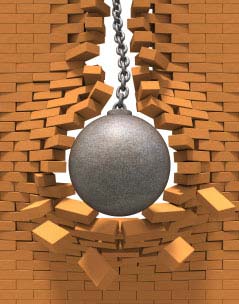Dismantle: Where Tradeshow Exhibit Damage is Done
Reduce Damage to Your Trade Show Exhibit During Post-Show Dismantling
Most tradeshows are open for 3 or 4 days. If you have ever been on the show floor during the last 2 hours of the show, you will see an amazing transition take place.
One week earlier there was an air of excitement and urgency as the exhibit crates were delivered to the booth spaces. Installation crews worked against the clock to get everything just right prior to the show opening. The night before the show, crews remove all of the empty crates and trash and roll out the aisle carpet. As the show opens, the sales staff arrive at their booths in their crisp business attire, anxious to grab anyone with an attendee badge and make their pitch.
 In contrast, by afternoon on the last day of the show, the booth staff is tired, the traffic is light and everyone is ready to rush to the airport. Often, the booth staff will be required to stay after the show closes and take down the booth. It is sufficient to say they most likely will not use the same care in taking the booth down as they did in setting it up. Expensive display components are often pulled, yanked and ripped down and then stuffed, smashed and crushed into shipping containers.
In contrast, by afternoon on the last day of the show, the booth staff is tired, the traffic is light and everyone is ready to rush to the airport. Often, the booth staff will be required to stay after the show closes and take down the booth. It is sufficient to say they most likely will not use the same care in taking the booth down as they did in setting it up. Expensive display components are often pulled, yanked and ripped down and then stuffed, smashed and crushed into shipping containers.
In the end, what seemed like a great way to save money, instead ends up costing you dearly. In my experience, there are a couple of ways to reduce the chances of damage during post-show dismantle. The first would be to pay an installation and dismantling company to dismantle and pack the booth. This is not always feasible, especially if you set the booth up yourself. If you cannot hire someone, then designate one or two members of your staff to stay at least one extra day to take care of dismantling the display. If these people know that they are not going to be flying out the night the show closes, they will be much more likely to take their time when packing the display.
A good double check is to have the display thoroughly inspected upon its return. If it has been improperly packed, you will want to know about it immediately so that you can have it repaired before its next use. Need an on-site tradeshow specialist there from set-up to tear-down? Let’s talk.
What to Look For in an Exhibit Design and Cost Proposal
Make sure your trade show costs fit into your budget.
One of the biggest challenges that exhibit marketers face is that their bosses give them a solid budget to do a show, but the vendors that they need to make it all happen refuse to lock into a quotation. This problem exists in just about every area of tradeshow expense.
 Most display companies will provide quotes for design and construction but do only “budgetary estimates” for field services. This leaves the door wide open to budget-blowing additional charges after the show. When clients ask for firm quotes for drayage, I&D, or electrical, their Account Executives deliver a well-rehearsed speech that they “cannot quote services that they can’t control,” or some other excuse their bosses have taught them.
Most display companies will provide quotes for design and construction but do only “budgetary estimates” for field services. This leaves the door wide open to budget-blowing additional charges after the show. When clients ask for firm quotes for drayage, I&D, or electrical, their Account Executives deliver a well-rehearsed speech that they “cannot quote services that they can’t control,” or some other excuse their bosses have taught them.
Also, General Services Contractors provide forms and other tools to allow trade show exhibitors to estimate their own field services costs but then insist on a credit card on file so that actual charges can be tacked on after the show. How in the heck do you budget for this?
There are exhibit companies that provide “turn key quotations” – if you absolutely cannot exceed a certain budget for a show, I would recommend that you find one. You will always have problems budgeting for hotel accommodations, travel expenses, and other show related costs, but you’ll at least be able to get the cost of your display, shipping, setup and dismantle, and utilities locked in.
We are ready to earn your business! Let’s talk.
A Perfect Tradeshow Vendor Relationship
Finding the perfect vendor to support your tradeshow program can be challenging, and there is no one-size-fits-all solution, but with the right things in mind, you can hit your target. As with any other decision, the preparation you put into it will greatly affect your level of success.
 Typically, the decision for an exhibit supplier is made during the purchase of a new display. It may seem logical that the company that built the display would be the best choice to manage it. Sometimes that may be true, but often the problem is that the companies that do the best job of design and presentation are not always the best at program management. Their company’s focus might be on designing and building new exhibits, leaving program management to take a back seat.
Typically, the decision for an exhibit supplier is made during the purchase of a new display. It may seem logical that the company that built the display would be the best choice to manage it. Sometimes that may be true, but often the problem is that the companies that do the best job of design and presentation are not always the best at program management. Their company’s focus might be on designing and building new exhibits, leaving program management to take a back seat.
A good start in your search is determining how much help you will need, and the size of your program:
- Pharmaceutical companies might exhibit in over 100 shows per year, not including other events that are a large part of their face to face marketing. Auto manufacturers exhibit in 65 or more shows in the span of a few months. These types of companies usually prefer to deal with the largest exhibit companies.
- Companies that participate in fewer shows each year in smaller configurations may not get the level of service that they need from a huge exhibit company, and often end up being the proverbial “small fish in a big pond.”
In order to find the best match for your needs, give some thought to how much support you will need from your exhibit company. Some companies need only basic assistance, such as storage, preparation and minor repairs. Others rely more heavily on an exhibit company to handle the entire show including show services, graphic design, shipping, etc. Be sure to consider how important your scale of business will be to your new vendor and whether you will have access to senior management in the event that problems occur.
While experience in your specific industry is a valuable thing, use caution in looking for a company that has several other clients in your most important show, as you may find that they are stretched too thin to provide the best service. Also, there are many other factors that contribute to the success of a vendor/client relationship, but a vendor’s efforts to become the best partner should always involve a willingness to listen and adapt to the client’s preferred ways of doing business.
Are you considering changing tradeshow vendors? Let’s Talk.
What is a Custom Tradeshow Exhibit?
Next to the word portable, the word custom is the least clearly defined term in the trade show business. Marketers from various display companies add “custom” to almost every product description. It sounds good and makes it easier to justify high costs.
 My definition of custom is something that is designed and constructed one at a time versus something that is engineered and mass produced. In general terms, display companies are either building displays one at a time or operating like a typical mass production company by designing products, doing the research and development and going into mass production.
My definition of custom is something that is designed and constructed one at a time versus something that is engineered and mass produced. In general terms, display companies are either building displays one at a time or operating like a typical mass production company by designing products, doing the research and development and going into mass production.
So, what does this mean to the buyer? There are advantages to both types.
Traditional Custom Exhibit Company
Designers at a traditional custom exhibit company can allow their imaginations to run wild and (assuming there is enough budget) the shop can produce it. There is no need to try and fit the design into a certain type of construction material or system. These displays are mostly unique but may end up to be heavier and bulkier.
System Component “Custom” Exhibit Company
Designers at a system type of company do some pretty amazing designs but are generally limited to using components from a catalog. The advantages to using system components are that they are, in general terms, better engineered, lighter weight and packaged more efficiently. Cost differences between the two types are negligible.
So, now that you know the difference, what do you do? In my opinion, if you are using the exhibit at 5 or fewer shows per year, buy the best design from a reputable supplier. If you go to more shows, the engineering and packaging issues are more important.
Either way, don’t be fooled by the word custom. Find out exactly how your display will be produced and make the choice that is right for you.
Archives
- July 2021
- June 2021
- May 2021
- April 2021
- October 2018
- September 2018
- August 2018
- July 2018
- June 2018
- May 2018
- April 2018
- March 2018
- February 2018
- January 2018
- December 2017
- November 2017
- October 2017
- September 2017
- August 2017
- July 2017
- June 2017
- May 2017
- April 2017
- March 2017
- February 2017
- January 2017
- December 2016
- November 2016
- October 2016
- September 2016
- August 2016
- July 2016
- June 2016
- May 2016
- April 2016
- March 2016
